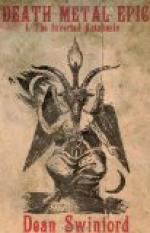Many years abode they there,
Many years in shade or sun,
In great gladness and delight.
Ne’er had Aucassin regret,
Nor his lady Nicolette.
Now my story all is done—
Said and sung!
FOOTNOTES:
[Footnote 12: All the quotations in this chapter are from Andrew Lang’s version of “Aucassin and Nicolette.”]
SPANISH EPICS
Literature was born in Spain only when the Christians began to reconquer their country from the Moors. The first literary efforts therefore naturally reflected a warlike spirit, and thus assumed the epic form. Very few of these poems still exist in their original shape save the Poema del Cid, the great epic treasure of Spain, as well as the oldest monument of Spanish literature. Besides this poem, there exist fragments of epics on the Infantes of Lara and on Fernan Gonzales, and hints of others of which no traces now remain. These poems were popularized in Spain by the juglares, who invented Bernardo del Carpio so as to have a hero worthy to offset to the Roland of the jongleurs,—their French neighbors. But the poems about this hero have all perished, and his fame is preserved only in the prose chronicles. In the Cronica rimada of the thirteenth century, we discover an account of the Cid’s youth, together with the episode where he slays Ximena’s father, which supplied Corneille with the main theme of his tragedy.
The Spaniards also boast of a thirteenth century poem of some twenty-five hundred stanzas on the life of Alexander, a fourteenth century romance about Tristan, and the chivalric romance of Amadis de Gaule, which set the fashion for hosts of similar works, whose popularity had already begun to wane when Cervantes scotched all further attempts of this sort by turning the chivalric romance into ridicule in his Don Quixote.
The Spaniards also cultivated the epic ballad, or romanceros, previous to the Golden Age of their literature (1550-1700), drawing their subjects from the history or legends of France and Spain, and treating mainly of questions of chivalry and love. Arthur, the Round Table, and the Quest for the Holy Grail, were their stock subjects, previous to the appearance of Amadis de Gaule, a work of original fiction remodelled and extended in the fifteenth century by Garcia Ordonez de Montalvo. During the Golden Age, Spain boasts more than two hundred artificial epics, treating of religious, political, and historical matters. Among these the Auracana of Erzilla, the Argentina of Centenera, and the Austriada of Rufo can be mentioned. Then Velasco revived the Aeneid for his countrymen’s benefit, and religious themes such as Azevedo’s Creacion del Munde became popular.
The latest of the Spanish epics is that of Saavedra, who, in his El Moro Exposito, has cleverly revived the old Spanish legend of the Infantes of Lara. It is, however, the Cid which is always quoted as Spain’s representative epic.




